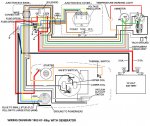I have a late 60's lark 40hp. I was told it has to be a 67 because it's seletric shift with a generator. (F,N,R).
I'm getting ready for the 2016 fishing season and would like her to keep the starting battery charged up.
I've got a good belt, and good fuses in the little wiring box, but According to my multimeter, no incoming current. Battery stays right at 12.5 when she's running and 12.4 when she's in gear. (obviously this goes down as the battery dies).
I was told something about "polarizing the generator", but am unsure what or how to do that.
I have somewhat more than basic electrical knowledge from working on cars for a living, but I've always delt with alternators.
There is what appears to be a voltage regulator in the grey junction box, with a few glass tube fuses.
What kind of voltage should this puppy put out? I expecting less than 5 amps, but even that would be able to recharge her after just running the fish finder for a while.
Any and all input is appreciated. Thanks!.
I'm getting ready for the 2016 fishing season and would like her to keep the starting battery charged up.
I've got a good belt, and good fuses in the little wiring box, but According to my multimeter, no incoming current. Battery stays right at 12.5 when she's running and 12.4 when she's in gear. (obviously this goes down as the battery dies).
I was told something about "polarizing the generator", but am unsure what or how to do that.
I have somewhat more than basic electrical knowledge from working on cars for a living, but I've always delt with alternators.
There is what appears to be a voltage regulator in the grey junction box, with a few glass tube fuses.
What kind of voltage should this puppy put out? I expecting less than 5 amps, but even that would be able to recharge her after just running the fish finder for a while.
Any and all input is appreciated. Thanks!.

























